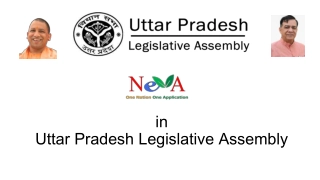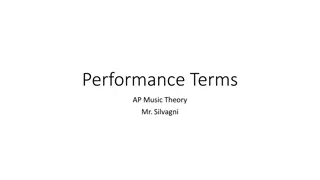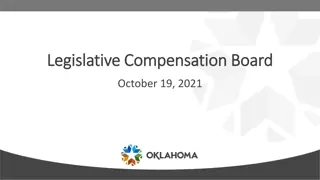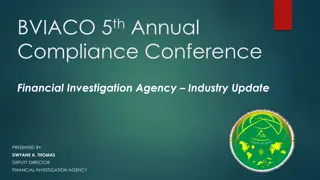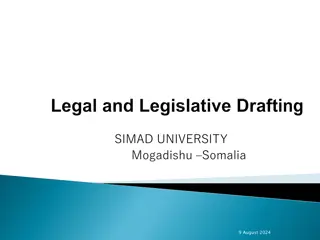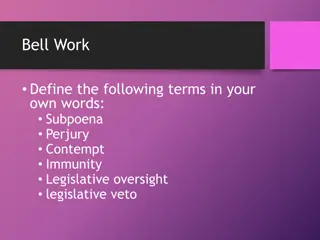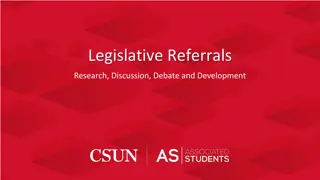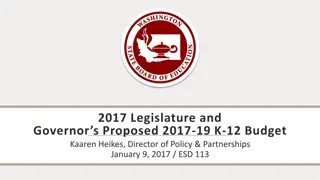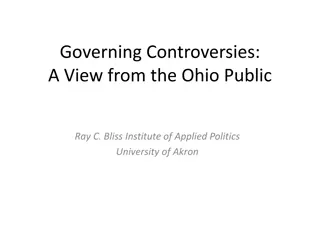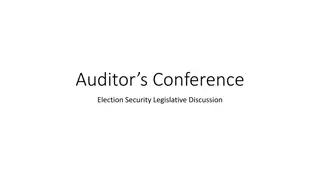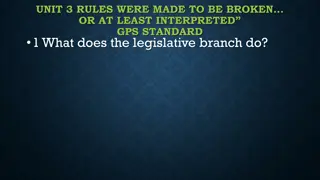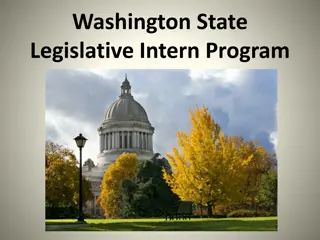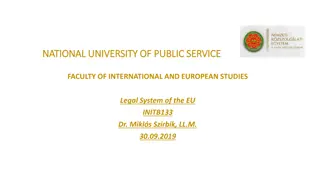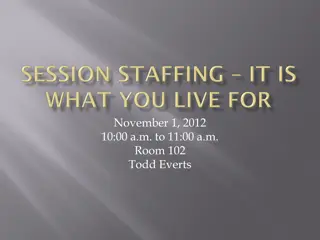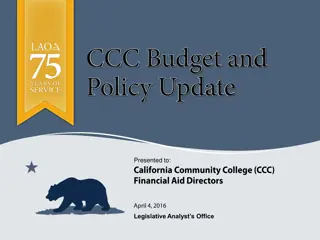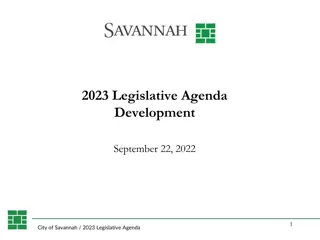Introduction to Legislative Processes - Key Terms and Procedures
In this informative presentation for the InterHab Annual Conference, we explore key terms and fundamental procedures within the Kansas Legislature. Topics covered include bill numbering, chambers, committee processes, final actions, roll call votes, vetoes, and more. Enhance your understanding of the legislative process with insights from Matt Fletcher, Executive Director of InterHab.
Download Presentation

Please find below an Image/Link to download the presentation.
The content on the website is provided AS IS for your information and personal use only. It may not be sold, licensed, or shared on other websites without obtaining consent from the author.If you encounter any issues during the download, it is possible that the publisher has removed the file from their server.
You are allowed to download the files provided on this website for personal or commercial use, subject to the condition that they are used lawfully. All files are the property of their respective owners.
The content on the website is provided AS IS for your information and personal use only. It may not be sold, licensed, or shared on other websites without obtaining consent from the author.
E N D
Presentation Transcript
Introduction to the Legislative Process InterHab Annual Conference Matt Fletcher Executive Director, InterHab
Politics ought to be the part-time profession of every citizen who would protect the rights and privileges of free people. - Dwight D. Eisenhower Politics. A word that can single-handedly cause eye-rolls, fistfights and holiday family gatherings to disintegrate into chaos. Many have a poor and inaccurate perception of how political and legislative processes work. Many others have decided to tune it all out. But we can t afford either of those approaches. Because we work with a population that historically has been underrepresented and undervalued in government. It s up to us to accomplish positive change on their behalf.
You cant play the game until you know the rules. Getting something accomplished in the legislative process requires that you have an understanding of how that process works. In this presentation, we are going to cover two of the most fundamental processes within the Kansas Legislature: The budget appropriation process How a bill becomes law
First, some key terms. Amendment A proposal to change or an actual change to a bill, a motion, an act, or the constitution. Appropriation A provision by a legislature of funds for a specific purpose. Bill Draft of a proposed new law, or amendments or repeal of existing laws. Bill Numbering A process of numbering bills as they are introduced from the beginning of each session. Bills bear the designation of the chamber in which they originate.
First, some key terms. Chamber Either the House of Representatives or the Senate. Committee of the Whole In Kansas, bills are usually debated, amended and recommended for passage in Committee of the Whole, then voted on by the full membership of either chamber the next day without debate. Conference Committee A committee composed of senators and representatives named to work out differences between same-subject bills passed by both chambers. Final Action When the House or Senate takes a final vote on a bill. At this point a bill must have a constitutional majority to pass.
First, some key terms. General Orders The section of the calendar listing bills to be taken up by the entire Kansas House or Senate. Occurs when either house sits as committee of the whole. Roll Call Vote The vote of each member is recorded. Roll call votes are required on final action. Table a Bill A motion to, in effect, put a bill aside and thereby remove it from consideration or kill it. Veto Governor of Kansas to return a bill or joint resolution unsigned to the House of origin in ten days of its delivery after passage, thereby preventing it from becoming law unless it can be re-passed over veto. The ten-day period excludes Sundays and holidays.
The budget appropriation process. One of the legislature s primary functions is the appropriation of funds for public purposes. It s often referred to as the power of the purse. The Kansas Legislature currently utilizes an annual budget cycle. In some previous years, a biennial or two-year cycle has been utilized. Every legislative session, the legislature must pass budget or appropriations measures in order to fund governmental functions for the State of Kansas. The legislative session usually lasts from mid-January to mid- May.
The budget appropriation process. This process begins every January with the Governor s office, which publishes a Governor s Budget Report for the next state fiscal year. State fiscal years are different from calendar years and run from July 1st of a year to June 30th of the next year. For example, we are currently in state fiscal year 2023, even though it s still 2022 on your calendars. The Governor s Budget Report includes budget recommendations for every department and agency within state government.
The budget appropriation process. Both chambers (the House of Representatives and the Senate) will begin deliberations that will ultimately lead to budget or appropriations bills being assembled in each chamber. Each chamber has dedicated committees for the purpose of considering budget matters. They are considered to be very powerful committees. The House Appropriations Committee is responsible for budget matters in the House of Representatives, while the Senate Ways and Means Committee considers appropriations bills for the Senate.
The budget appropriation process. Both the House Appropriations Committee and the Senate Ways and Means Committee use a system of subcommittees or connected committees to consider budget items around specific topic areas. The House Social Services Budget Committee and the Senate Ways and Means Subcommittee on Human Services are responsible for budget matters that impact the IDD service network. Both of the above committees typically begin holding hearings on budget matters in February. Hearings provide an opportunity for advocates to offer testimony on items they want the committees to consider increasing funding for.
The budget appropriation process. By early March, the Social Services Budget Committee and Senate Ways and Means Subcommittee on Human Services will prepare recommendations for the House Appropriations Committee and the Senate Ways and Means Committee on funding items. Those recommendations can either be accepted as is, amended or rejected. The House Appropriations Committee and Senate Ways and Means Committee will assemble the recommendations from subcommittees as the beginning of mega budget bills for each chamber to eventually consider.
The budget appropriation process. By mid to late March, the House Appropriations Committee and Senate Ways and Means Committees will consider their mega budget bills. If the bills pass out of each committee, their next stop will be consideration by the full membership of each chamber. If each chamber passes their budget bills, a special process known as conferencing must occur in order for the two chambers to negotiate on any differences between their budget bills. A conference committee will be formed of three members from each chamber who will negotiate. Once the conference committee has completed their work, a conference committee report will be completed, containing the negotiated outcomes.
The budget appropriation process. Each chamber then gets an opportunity for an up or down vote on the conference committee report. No amendments can be made. If the conference committee report is approved by each chamber, the legislature s budget work is essentially done. A final version of the budget bill will be enrolled and sent to the governor. The governor has ten days (minus Sundays and holidays) upon receipt to sign the bill into law, veto the bill, or line-item specific measures in the bill (something she can only do for budget bills). The governor could also choose to simply not sign the bill and passively allow it to become law.
How a bill becomes law. The process for a bill is different than the budget process and much more varied. Let s take a look at a common path that bills can take. But first, what is a bill?
How a bill becomes law. The bill is introduced (one or both chambers) Referred to a committee Committee hearing Committee works the bill Table means trouble Committee passes bill Sent to the full chamber
How a bill becomes law. Needs to get above the line General Orders Final Action Sent to the other chamber to go through the same process If it passes both chambers, it s on to the governor Ten days to sign it into law or veto it
Your one-stop shop for the KS Legislature. www.kslegislature.org
Thank you! Matt Fletcher mfletcher@interhab.org


